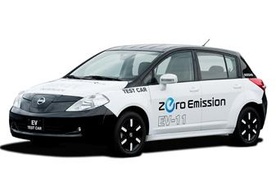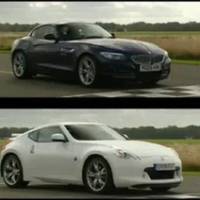The Japanese manufacturer previewed its all electric Nissan Tiida prototype today demonstrating the company’s new EV-IT system developed to support electric driving 24/7.
The Nissan Tiida all electric car prototype features an electric motor that generates 80 kW and 280 Nm of torque and a 23kWh lithium-ion battery pack placed under the vehicle floor. With this hybrid powering system the car can cover as much as 160 Km when starting on a fully charged battery.
As far as interior gadgets the Nissan Tiida all electrical prototype is fitted with a sophisticated IT system that connects the vehicle to a global data centre and receives info regarding the battery’s maximum range and updates on charging stations.
The Nissan Tiida EV is expected to hit the US and Japan markets somewhere in 2010.
Nissan press release :
Nissan Motor Co., Ltd. today previewed its electric vehicle (EV) platform on a Tiida-based prototype to demonstrate the superior driving pleasure of a pure zero-emission vehicle. It also showcased a sophisticated EV-IT system developed to support electric driving 24/7 (24 hours a day, 7 days a week).
The dedicated EV platform is comprised of a highly rigid body, high-performance motor, compact lithium-ion battery with high power output and energy capacity, delivering outstanding driving performance and safety, while offering a quiet and peaceful driving experience – a unique feature of a fully-electric drivetrain.
The in-house developed electric motor delivers 80kW/280Nm for high response and powerful acceleration. Nissan’s unique motor control also contributes to the vehicle’s seamless acceleration.
The 24kWh laminated compact lithium-ion battery pack is placed under the vehicle floor for more efficient packaging, without compromising cabin or cargo space. The battery layout also allows smooth underfloor air-flow which helps reduce drag. Additionally, the regenerative brake system employed to recharge the battery during deceleration and braking extends the driving range to more than 160km*1 under a full charge.
High durability is achieved by employing an additional frame for the battery pack to significantly improve the rigidity of the platform. The combination of a high rigidity platform and electric powertrain minimizes vibration and external sounds to produce a quiet and pleasing drive.
<EV-IT support function>
Nissan has developed an sophisticated IT system for its zero-emission EVs, connecting the vehicle’s on-board transmitting unit to a global data center*2 to support EV driving 24 hours 7 days a week.
Usability and convenience for EV driving is achieved via the following:
Maximum range display
* With a simple touch of a button, the navigation map shows the driving radius within range under the current state of charge.
* The system can calculate if the vehicle is within range of a pre-set destination.
Update on charging stations
* The navigation system points out the latest information on available charging stations within the current driving range.
* Detailed information for each charging station will also be displayed.
Timer function
* The timer function enables the air-conditioner or battery charging to begin at a specified time. The air-conditioner can be pre-set while the vehicle is plugged-in to cool the cabin to a desirable temperature before driving begins, without taxing the vehicle’s battery. Meanwhile, the battery charging can be set to start at a specified time at night to benefit from more favorable electricity rates.
EV remote control and monitoring function
* The driver can monitor the state-of-charge of the EV via an online website and a cellular phone. For example, when the battery is fully charged, a message alert is sent to the cellular phone. Additional remote control functions range from switching the charging system ON/OFF or setting the air-conditioner timer.
To be a leader in zero-emission mobility, Nissan is progressing its development for electric vehicles and the key components. The all-electric vehicle slated for launch in 2010 will have a unique design and body. Nissan plans to unveil the design of the production EV at its new Global Headquarters Opening in Yokohama on August 2nd. A Nissan Zero-emission Website (www.nissan-zeroemission.com) will also go live on Aug. 2nd.
Nissan has been addressing a wide range of actions under "Blue Citizenship" which represents the company’s desire to protect the blue planet and to be a corporate citizen that can live symbiotically with people and society. These efforts range from such global issues as the environmental protection to contribution to communities, promoting diversity and making personal mobility available to as many people as possible. Nissan continues promoting the development of zero-emission vehicles based on the "Blue Citizenship" spirit by introducing effective technologies, products and services into the market.
1. *1: US LA4 mode. Actual range may vary depending on driving style and conditions.
2. *2: Global data center: A globally common platform to provide identical telematics services via mobile network by connecting internet and vehicle IT system.
Nissan Motor Co., Ltd., a long-time leader in the development and application of CVT (Continuously Variable Transmission) technology, and its affiliate transmission supplier JATCO Ltd. today announced the joint development of a new generation of compact and lightweight CVTs.
The next-generation CVT design features an innovative structure combining conventional CVT belt operation with an auxiliary gearbox and a significantly increased gear ratio range. The new CVT is scheduled to appear in compact Nissan vehicles worldwide in the near future.
Major features of the new CVT are:
– World’s highest transmission ratio for quicker starts and acceleration
The new structure raises the available transmission ratio from current 6.0:1 to 7.3:1, more than 20 percent higher than other CVTs, for enhanced responsiveness on starting and acceleration. The 7.3:1 ratio is higher than the average conventional 7-speed automatic transmissions used on high-displacement engine-equipped vehicles, making it among the world’s highest ratios for production vehicle use*.
– Compact and lightweight
This revolutionary CVT configuration combines a belt-operated CVT with an auxiliary transmission, shortening its overall length by 10 percent and reducing weight by 13 percent compared to conventional CVTs in its class.
– Superb drivability
The next-generation CVT features the Adaptive Shift Control (ASC), which improves performance by automatically selecting the best ratio for startup, acceleration and uphill or downhill driving.
"Nissan believes the CVT has very good potential as a leading technology for raising the fuel efficiency of internal-combustion engine systems," said Shuichi Nishimura, corporate vice president, Nissan Powertrain Engineering Division. "Nissan first began applying CVT technology in 1991 and has been continuously evolving CVTs, engine-cooperative management and other systems, and expanding their use in Nissan vehicles. The need to improve fuel economy, with the resulting reductions in CO2 emissions motivated us to step up our efforts in the joint development with JATCO of this next-generation CVT."
JATCO, the world’s leading CVT manufacturer, is the only company that offers a full range of CVTs for applications from mini-vehicles up to 3.5-liter V6-equipped cars. The company produces 43 percent of CVTs made globally.
"The revolutionary structure of the next-generation CVT, with its auxiliary transmission, not only raises the transmission ratio, reduces weight and adds fuel efficiency, its compact design also expands its applicability to a broader range of vehicles,” said Yo Usuba, vice president, JATCO. “We believe it is an excellent choice for automakers seeking to raise the fuel efficiency of their smaller cars."
Based on the mid-term environmental program "Nissan Green Program 2010," Nissan and JATCO have achieved sales of 1 million CVT-equipped vehicles, as well as introducing 7-speed automatic transmissions to improve fuel efficiency. The companies will continue to introduce effective technologies and products into the market in pursuit of a sustainable mobility society.
* Excluding DCTs and manual transmissions.



